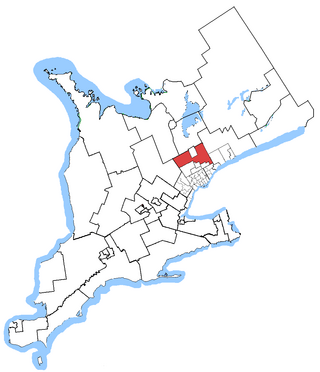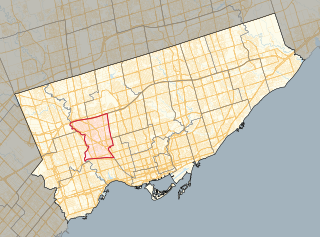
Queen Street is a major east–west thoroughfare in Toronto, Ontario, Canada. It extends from Roncesvalles Avenue and King Street in the west to Victoria Park Avenue in the east. Queen Street was the cartographic baseline for the original east–west avenues of Toronto's and York County's grid pattern of major roads. The western section of Queen is a centre for Canadian broadcasting, music, fashion, performance, and the visual arts. Over the past twenty-five years, Queen West has become an international arts centre and a tourist attraction in Toronto.

Oak Ridges—Markham was a federal electoral district in Ontario, Canada, that was represented in the House of Commons of Canada from 2004 to 2015. Its population in 2006 was 169,645., with 136,755 electors, the highest of any riding in Canada. By 2011, the riding's population had risen to 228,997, the largest population of all ridings in Canada.

Trinity—Spadina was a federal electoral district in Ontario, Canada, that was represented in the House of Commons of Canada from 1988 to 2015.

Parkdale—High Park is a federal electoral district in Ontario, Canada, that has been represented in the House of Commons of Canada since 1979. It was created during the 1976 electoral boundaries redistribution from parts of Parkdale, High Park—Humber Valley, Davenport and Spadina districts. As of the October 19, 2015, Canadian general election, the current Member of Parliament (MP) is Liberal member Arif Virani. According to the 2016 census, Parkdale—High Park has the lowest percentage of visible minorities (26.2%) among all City of Toronto ridings; it also has the highest percentage of people of Irish (20.0%), German (9.8%), and French (8.9%) ethnic origin of all City of Toronto ridings.

Spadina Avenue is one of the most prominent streets in Toronto, Ontario, Canada. Running through the western section of downtown, the road has a very different character in different neighbourhoods.

Trinity was an electoral district in Ontario, Canada, that was represented in the House of Commons of Canada, 1935 to 1988. It covered a portion of western Toronto, Ontario. Its name comes from the Trinity–Bellwoods area where Trinity College, Toronto was located.

Toronto—St. Paul's is a federal electoral district in Toronto, Ontario, Canada, that has been represented in the House of Commons of Canada since 1935. Before the 2015 election, the riding was known as St. Paul's.

Toronto Centre is a federal electoral district in Toronto, Ontario, Canada, that has been represented in the House of Commons of Canada from 1872 to 1925, and since 1935, under the names Centre Toronto (1872–1903), Toronto Centre, Rosedale (1935–1997), and Toronto Centre—Rosedale (1997–2004).
Parkdale was a Canadian federal electoral district represented in the House of Commons of Canada from 1917 to 1979. It included the community of Parkdale in the western part of Toronto, Ontario. It was created in 1914 from Toronto West, and continued to exist until 1976 when most of it was merged into Parkdale—High Park with some sections into Trinity.

York South—Weston is a federal electoral district in Ontario, Canada, that has been represented in the House of Commons of Canada since 1979.

Scarborough—Rouge River was a federal electoral district in Ontario, Canada, that has been represented in the House of Commons of Canada between 1988 and 2015. However, as of the Fall 2015 federal election, part of this riding has been combined with the south-western part of the old riding Pickering—Scarborough East.

Toronto South was a federal electoral district represented in the House of Commons of Canada from 1904 to 1935. It was located in the city of Toronto in the province of Ontario. This riding was first created in 1903 from parts of Toronto Centre, Toronto East, West Toronto and York East ridings.

Toronto West was a federal electoral district in the City of Toronto, Ontario, Canada, that was represented in the House of Commons of Canada from 1904 to 1925. This riding was created in 1903 when West Toronto riding was renamed, and reduced from electing two members of the House of Commons to one.
Toronto West Centre was a federal electoral district represented in the House of Commons of Canada from 1925 to 1935. It was located in the province of Ontario. This riding was created in 1924 from parts of Toronto Centre and Toronto West ridings.

Bellwoods was a provincial riding in Ontario, Canada in the old City of Toronto's west-end. It was represented in the Legislative Assembly of Ontario from 1926 until 1987, when it was abolished and redistributed into the Dovercourt, and Fort York districts.

Trinity—Spadina was a provincial electoral district in Ontario, Canada, that was represented in the Legislative Assembly of Ontario since 1999.

Bracondale was a provincial electoral district in Toronto, Ontario, Canada. It was represented in the Legislative Assembly of Ontario from 1926 to 1967. The constituency got its name from an old Toronto suburb called Bracondale, that was annexed by Toronto in 1909. Its most notable event was electing one of the first two women Members of the Provincial Parliament (MPP) to share the title "first-woman MPP" in 1943 when Rae Luckock was elected. In 1965, Bracondale's MPP, Joseph Gould, died in office sparking the final election held in the constituency. George Ben won the by-election, and became the constituency's last MPP. It was abolished for the 1967 Ontario provincial election, and redistributed into the Dovercourt and Bellwoods constituencies. As of 2023, the current electoral districts of Davenport, St. Paul's, University–Rosedale, and Spadina–Fort York encompass this historic riding.

Parkdale was a provincial riding electing Members of Provincial Parliament (MPP) to the Legislative Assembly of Ontario. The riding was created from the western part of Toronto West riding in 1914 and abolished in 1996 and redistributed into the Parkdale—High Park, Davenport and Trinity—Spadina ridings for the 1999 Ontario general election.

Spadina—Fort York is a federal electoral district in Toronto, Ontario, Canada.

University—Rosedale is a federal electoral district in Ontario, Canada, that has been represented in the House of Commons of Canada since 2015. The riding is currently represented by Chrystia Freeland, former Minister of Finance and former deputy prime minister of Canada.
















